Indian Economy on the Eve of Independence Class 12 Economics
| Table of contents |

|
| Introduction |

|
| Low Level of Economic Development Under Colonial Rule |

|
| Agriculture Sector |

|
| Industrial Sector |

|
| Foreign Trade |

|
| Demographic transition |

|
| Infrastructure |

|
| Conclusion |

|
Introduction
- India had an independent economy before the arrival of British rule.
- Before this period, India had a thriving economy with successful handicrafts and robust agriculture.
- The country was especially famous for its handicraft industries, including cotton and silk textiles, as well as metalwork and precious stone crafts.
- However, the British colonial rule aimed to turn India into a supplier of raw materials for Great Britain's rapidly growing industrial needs.
- This approach caused the downfall of local industries, worsened agricultural issues, and left India impoverished.
- The British government's control over India resulted in the collapse of its renowned handicraft sectors without making any significant contribution to establishing a modern industrial foundation.
- The agricultural sector continued to suffer from stagnation and decline, even though it was the primary source of sustenance for the majority of the Indian population.
- As India approached independence, understanding the exploitative nature of this relationship is crucial for assessing the level of development the Indian economy has achieved over the last seventy-five years.
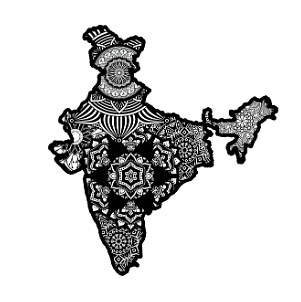
Low Level of Economic Development Under Colonial Rule
- India was an independent, self-reliant and prosperous economy.
- Agriculture was the main source of livelihood for most of the people. Yet, the country’s economy was characterized by various kinds of manufacturing activities.
- India was renowned for its handicrafts industries, especially in cotton and silk textiles, metalwork, and precious stones. These goods were popular worldwide due to their high-quality materials and craftsmanship. For example, Muslin, a cotton textile from Dhaka in Bengal, was famous for its luxurious texture. The British government's rule caused the decline of these handicraft industries without creating a modern industrial base to replace them.
- Objectives/Nature of British policy in India: The main aim of British colonial rule was to turn India into a supplier of raw materials for Britain's growing modern industries.
- The colonial government's strategy to de-industrialise India had two primary goals: to make India a supplier of essential raw materials for British industries and to create a large market for the finished products of those industries, ensuring continuous growth for Britain.
- Economists who tried to assess India’s national and per capita income included Dadabhai Naoroji, William Digby, Findlay Shirras, V. K. R. V. Rao, and R. C. Desai, as the British government never made serious attempts to do so.
- Despite being crucial for the majority of the population, the agricultural sector faced stagnation and decline.
- Studies indicated that growth in India's overall output during the first half of the twentieth century was below two per cent, with a minimal growth of half a per cent in per capita output per year.
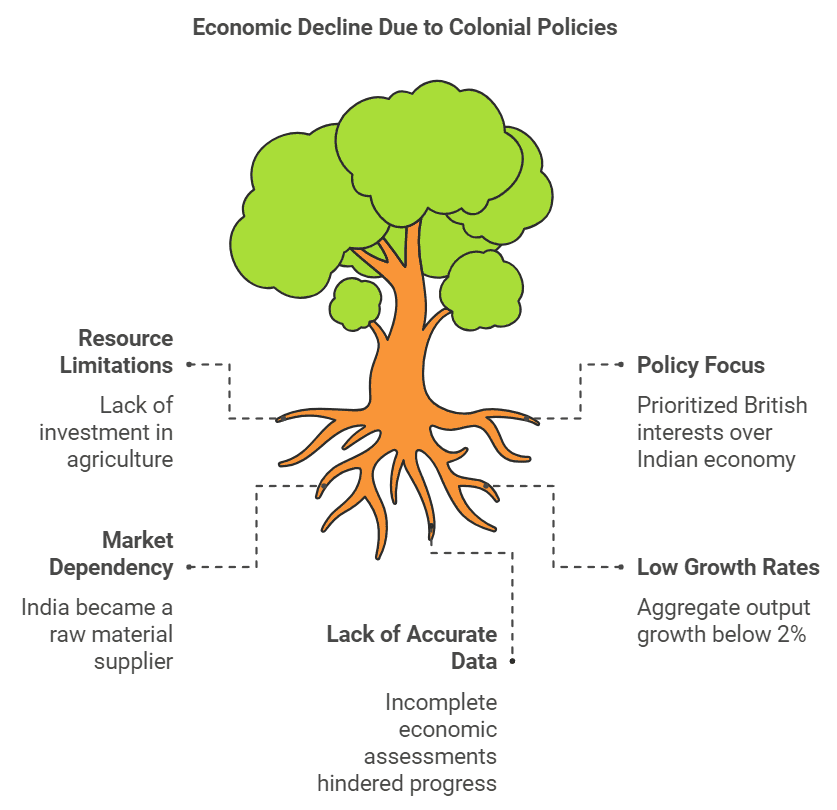
Agriculture Sector
Under the British colonial rule, India was primarily an agrarian economy with about 85% of country’s population living in villages and deriving their livelihood directly or indirectly from agriculture. However, despite a large proportion of population being engaged in agriculture, the Indian agriculture sector continued to experience stagnation and low productivity during British rule.
The main causes for this were:
1. Land Settlement System
- The colonial government introduced various land settlement systems, such as the Zamindari System in the Bengal presidency (now parts of eastern India).
- Profits from agriculture went to zamindars rather than the actual cultivators.
- Zamindars did not work to enhance agricultural conditions.
- Their primary concern was to collect rent, regardless of the cultivators' situations.
- This led to significant hardship and social unrest among farmers.
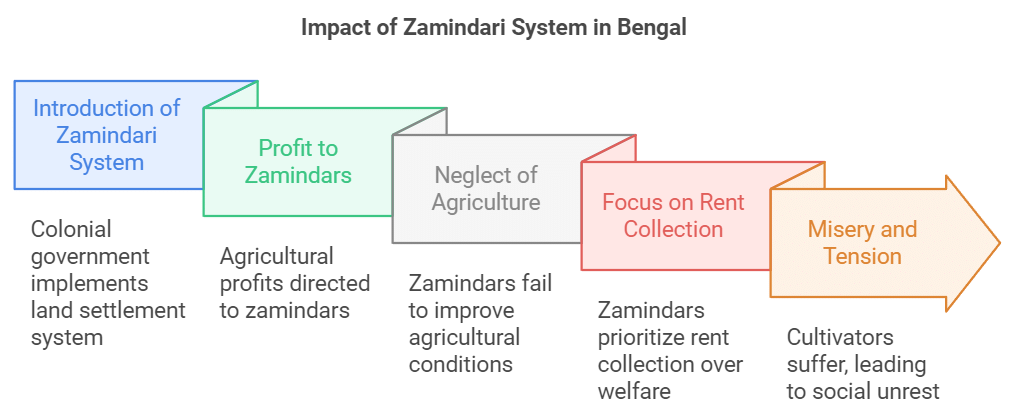
2. Revenue settlement system
- There were fixed deadlines for paying specified revenue amounts; failure to pay meant zamindars would lose their rights.
- This resulted in the exploitation of farmers by zamindars.
3. Use of primitive techniques of production
- Indian agriculture relied heavily on manual labour, with few machines available.
- Low technology levels, a lack of irrigation facilities, and minimal use of fertilisers contributed to poor agricultural productivity.
4. Commercialisation of agriculture
- This refers to producing crops for sale rather than for personal use.
- During British rule, farmers were encouraged to grow cash crops instead of food crops, often receiving better prices for crops like cotton or jute, which were used by British industries. However, this did not improve farmers' financial situations.
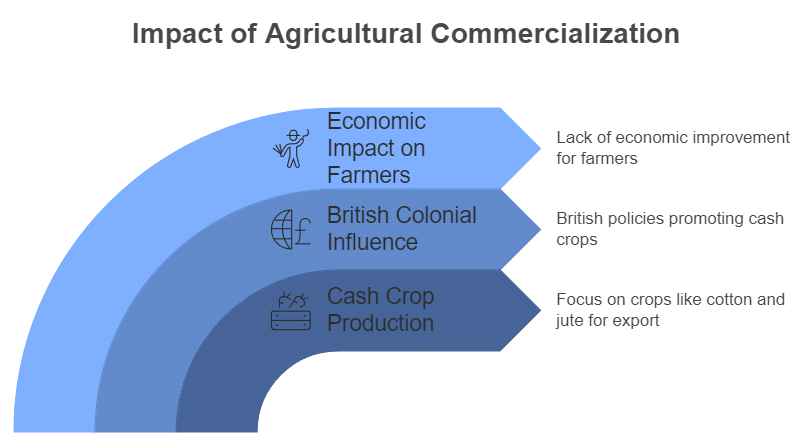
5. Lack of investment from government and farmers
- Problems with irrigation: Although some advancements were made, India's agriculture suffered from underinvestment in terracing, flood control, drainage, and soil desalinisation.
- While some farmers shifted to commercial crops, many tenants, small farmers, and sharecroppers lacked the necessary resources and technology and had no motivation to invest in agriculture.
Industrial Sector
India could not develop a sound Industrial base under the colonial rule due to the following reasons:
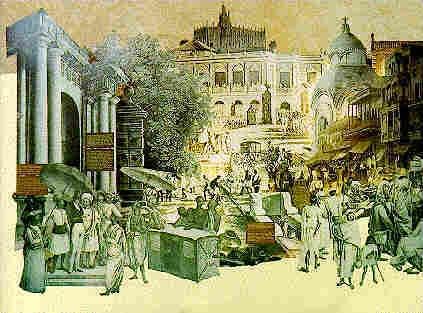
- Systematic Deindustrialisation policy: The main aim of the colonial government with this policy was twofold: 1. To make India a simple supplier of vital raw materials for Britain's modern industries. 2. To establish India as a large market for British manufactured goods.
- Destruction of handicraft industry: The decline resulted from the widespread collapse of traditional handicraft industries in India, leading to significant unemployment and a new demand in the Indian market that was largely satisfied by cheap imported goods from Britain.
- Slow growth of modern industries: Modern industries began to emerge in India in the late 19th century, but their development was sluggish. Initially, these industries focused on cotton and jute textile mills. The cotton mills, mostly run by Indians, were situated in western India, particularly in Maharashtra and Gujarat, while the jute mills, primarily operated by foreigners, were concentrated in Bengal. Later, iron and steel industries began to develop in the early 20th century, with the establishment of the Tata Iron and Steel Company (TISCO) in 1907. Other industries such as sugar, cement, and paper appeared after the Second World War.
- Lack of capital goods industry: Capital goods industries produce machinery and tools that are used to make products for everyday use. During British rule, there was very little development of capital goods industries to support further industrial growth in India.
- Inadequate industrial growth: The growth rate of the new industrial sector and its contribution to the Gross Domestic Product (GDP) or Gross Value Added was minimal.
- Limited role of public sector: This sector was mainly focused on railways, power generation, communications, ports, and a few other government projects. The independent Indian government needed to build upon this foundation through strategic planning.
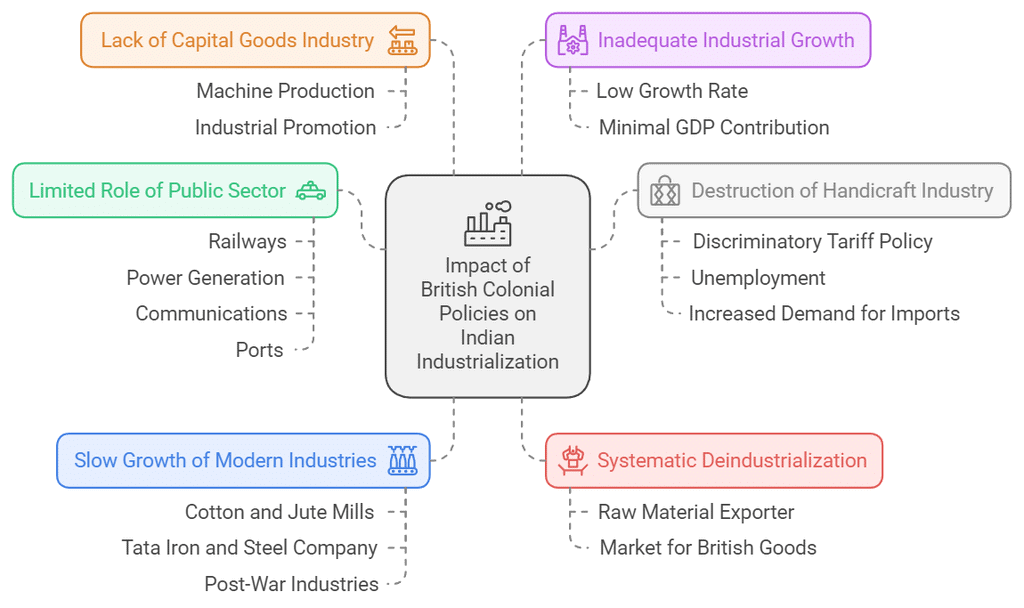
Foreign Trade
The restrictive policies of commodity production, trade and tariff pursued by the colonial government adversely affected India’s foreign trade in the following respects:
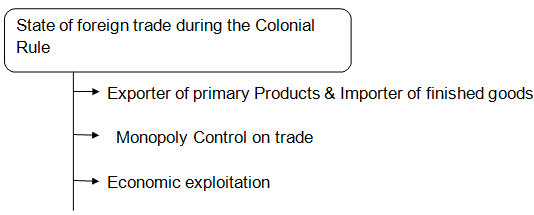
- Change in the composition of trade: Throughout the colonial period, India's foreign trade was marked by a significant export surplus. Consequently, India became an exporter of primary products such as raw silk, cotton, wool, sugar, indigo, and jute, while importing finished consumer goods like cotton, silk, and woollen clothes, as well as capital goods like light machinery from Britain.
- Change in the direction of trade: Britain held a monopoly over India's exports and imports. As a result, over half of India's foreign trade was conducted with Britain, with limited trade occurring with a few other countries like China, Ceylon (Sri Lanka), and Persia (Iran).
- Change in volume of trade: The opening of the Suez Canal in 1869 further tightened British control over India's foreign trade by lowering transportation costs and facilitating easier access to the Indian market.
- Change in the structure of trade: India's foreign trade created a large export surplus. However, this surplus came at a great cost to the economy, leading to shortages of essential items like food grains, clothing, and kerosene in the local market due to the export of primary products (raw materials).
- Use of export surplus: This export surplus was primarily used to cover expenses for the colonial government’s offices in Britain, to fund military conflicts fought by the British government, and to pay for imports of invisible items.
All these led to the drain of Indian wealth.
Demographic transition
Demographic transition is the shift from high birth and death rates to low birth and death rates as a country develops. This process usually results in slower population growth and a more stable population over time.
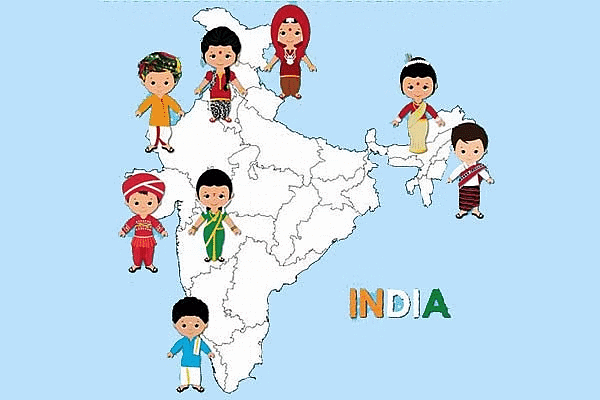
India’s first official census operation was undertaken in 1881. It revealed that India’s population growth was uneven. Before 1921, India was in the first stage of demographic transition. The second stage of transition began after 1921. However, neither the total population of India nor the rate of population growth at this stage was very high. Hence, the year 1921 is also called the ‘Year of Great Divide.’ The social development indicators during British rule were not encouraging:
- The overall literacy level was less than 16%, with female literacy at a very low 7%.
- Public health facilities were either unavailable to many people or, when available, were inadequate. As a result, diseases spread easily and caused many deaths.
- The overall mortality rate was very high, especially the infant mortality rate, which was about 218 per thousand, compared to the current 33 per thousand.
- Life expectancy was also very low at just 32 years, whereas it is now 69 years.
- Although reliable data is scarce, it is clear that widespread poverty existed during colonial times, which contributed to the poor condition of India's population.
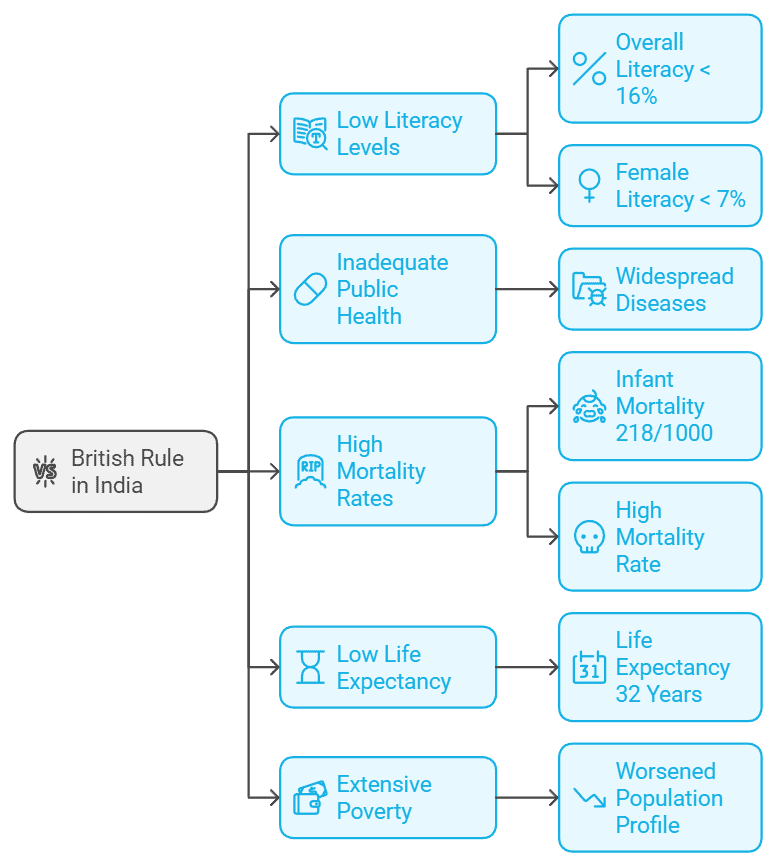
 |
Download the notes
Chapter Notes - Indian Economy on the Eve of Independence
|
Download as PDF |
Occupational Structure
Occupational Structure refers to the distribution of working persons across different industries and sectors.
Features of India’s pre-independence occupational structure:
- The agriculture sector accounted for the largest share of the workforce, i.e., 70-75%.
- The manufacturing and the service sectors accounted for only 10% and 15-20% respectively.
- There was growing regional variation. The states of Tamil Nadu, Andhra Pradesh, Kerala and Karnataka (Parts of the then Madras Presidency), Bombay (Maharashtra) and West Bengal witnessed a decline in the dependence of the workforce on the agricultural sector with a commensurate increase in the manufacturing and service sector. However, during the same time, there had been an increase in the share of the workforce in agriculture in states such as Orissa, Rajasthan and Punjab.
Infrastructure
During British rule, basic infrastructure facilities such as railways, ports, water transport, posts and telegraphs did develop, however, the main aim behind such development was to serve various colonial interests rather than providing basic amenities to the people.
- Roads were constructed mainly to move the army around India and to transport raw materials from rural areas to the nearest railway station or port for shipping to England. There was always a significant lack of all-weather roads to reach rural areas during the rainy season, which severely impacted those living in these regions, especially during natural disasters and famines.
- Railways were introduced by the British in 1850 and are regarded as one of their most significant contributions. The railways changed the Indian economy in two key ways: they allowed people to travel long distances, breaking geographical and cultural barriers, and promoted the commercialisation of Indian agriculture, which negatively impacted the self-sufficiency of village economies.
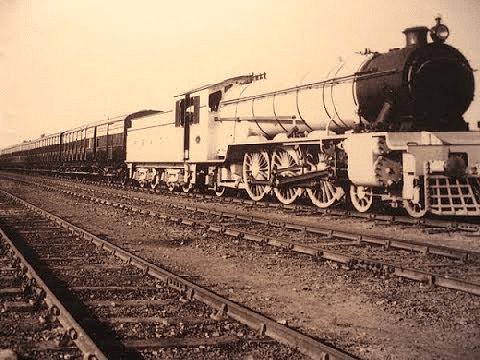 Indian Railways under the Colonial Rule
Indian Railways under the Colonial Rule
- The railways affected the structure of the Indian economy in two important ways:
1. It enabled people to undertake long-distance travel and thereby break geographical and cultural barriers.
2. It fostered the commercialisation of Indian agriculture which adversely affected the self-sufficiency of the village economies in India. - India’s volume of exports increased significantly, but the Indian people did not benefit; instead, the British government reaped the rewards. The social advantages that the Indian population gained from the railways were outweighed by the substantial economic losses faced by the country.
- Waterways: Besides railways and roads, the British government also took measures for the development of inland trade and sea lanes (water transport). However, these measures were far from satisfactory.
The inland waterways developed by the British proved to be uneconomical, as in the case of the Coast Canal on the Orissa coast. This canal was built at a huge cost, but it failed to compete with railways, and finally, it had to be abandoned. - Post and telegraph: The British introduced an expensive system of electric telegraph in India, which served the purpose of maintaining law and order.
The postal services, despite serving a useful public purpose, remained all through inadequate.
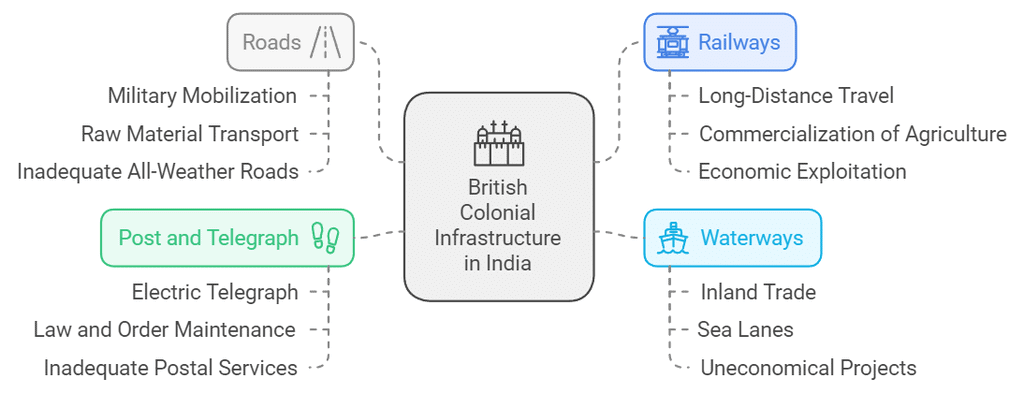
Note: (a) Tata Airlines, a division of Tata and Sons was established in 1932 inaugurates the aviation sector in India.
(b) The British also started the modern education system for the purpose of creating clergy class.
(c) They also laid the foundation of modern banking system in India for administrative purposes i.e. maintaining accounts for the British in India. (Positive contributions of British rule).
Conclusion
- By the time India achieved independence, the effects of over two centuries of British colonial rule were already evident in all areas of the Indian economy.
- The agricultural sector faced issues like having too many workers and very low productivity. Despite this, it continued to decline, even though a large part of India's population relied on it for their livelihoods.
- The decline of India’s renowned handicraft industries due to British actions did not lead to the establishment of a new industrial foundation in India, nor did it significantly contribute to a modern industrial sector.
- As a result, the industrial sector lacked modernisation, diversification, capacity development, and sufficient public investment.
- Foreign trade was primarily focused on supporting the Industrial Revolution in Britain.
- While the colonial government made some attempts to enhance infrastructure, these were driven by self-serving interests, meaning significant upgrades and expansions were necessary.
- The widespread issues of poverty and unemployment highlighted the need for a welfare-focused public economic policy.
- In summary, the social and economic challenges facing the country were immense.
|
63 videos|287 docs|52 tests
|
FAQs on Indian Economy on the Eve of Independence Class 12 Economics
| 1. What was the impact of colonial rule on the agricultural sector in India? |  |
| 2. How did the industrial sector develop under British colonial rule? |  |
| 3. What were the characteristics of foreign trade during the colonial period in India? |  |
| 4. How did colonial rule affect the demographic transition in India? |  |
| 5. What was the state of infrastructure development in India before independence? |  |


























